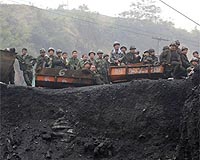 |
Durham NC (SPX) Dec 01, 2010 As the Environmental Protection Agency weighs whether to define coal ash as hazardous waste, a study by Duke University researchers identifies new monitoring protocols and insights that can help investigators more accurately measure and predict coal ash contaminants' ecological impacts. "The take-away lesson is we need to change how and where we look for coal ash contaminants," says Avner Vengosh, professor of geochemistry and water quality at Duke's Nicholas School of the Environment. "Risks to water quality and aquatic life don't end with surface water contamination, but much of our current monitoring does." The study, published online this week in the peer-reviewed journal Environmental Science and Technology, documents contaminant levels in aquatic ecosystems over an 18-month period following a massive coal sludge spill in 2008 at a Tennessee Valley Authority power plant in Kingston, Tenn. By analyzing more than 220 water samples collected over an 18-month period, the Duke team found that high concentrations of arsenic from the TVA coal ash remained in pore water - water trapped within river-bottom sediment - long after contaminant levels in surface waters dropped back below safe thresholds. Samples extracted from 10 centimeters to half a meter below the surface of sediment in downstream rivers contained arsenic levels of up to 2,000 parts per billion - well above the Environmental Protection Agency's thresholds of 10 parts per billion for safe drinking water, and 150 parts per billion for protection of aquatic life. "It's like cleaning your house," Vengosh says of the finding. "Everything may look clean, but if you look under the rugs, that's where you find the dirt." The potential impacts of pore water contamination extend far beyond the river bottom, he explains, because "this is where the biological food chain begins, so any bioaccumulation of toxins will start here." The research team, which included two graduate students from Duke's Nicholas School of the Environment and Pratt School of Engineering, also found that acidity and the loss or gain of oxygen in water play key roles in controlling how arsenic, selenium and other coal ash contaminants leach into the environment. Knowing this will help scientists better predict the fate and migration of contaminants derived from coal ash residues, particularly those stored in holding ponds and landfills, as well as any potential leakage into lakes, rivers and other aquatic systems. The study comes as the EPA mulls whether to define ash from coal-burning power plants as hazardous waste. The deadline for public comment to the EPA was November 19; a final ruling - what Vengosh calls "a defining moment" - is expected in coming months. "At more than 3.7 million cubic meters, the scope of the TVA spill is unprecedented, but similar processes are taking place in holding ponds, landfills and other coal ash storage facilities across the nation," he says. "As long as coal ash isn't regulated as hazardous waste, there is no way to prevent discharges of contaminants from these facilities and protect the environment." Laura Ruhl, a PhD student in Vengosh's lab, is lead author of the study, which was funded by the National Science Foundation. Vengosh is corresponding author. Coauthors are Gary S. Dwyer, senior research scientist; Heileen Hsu-Kim, assistant professor of environmental engineering; and Amrika Deonarine, a PhD student in Hsu-Kim's lab.
Share This Article With Planet Earth
Related Links Duke University Powering The World in the 21st Century at Energy-Daily.com
 Disease In Rural China Linked To Polluted Coal
Disease In Rural China Linked To Polluted CoalWashington DC (SPX) Oct 27, 2010 In remote, rural areas of southwestern China, villagers cook and dry their clothes by burning pieces of coal they pick up off the ground. This fuel releases a toxin that may be poisoning millions of people, according to an ongoing investigation by chemists at the University at Buffalo in New York. The researchers presented their work at the AVS 57th International Symposium and Exhibition, ... read more |
|
| The content herein, unless otherwise known to be public domain, are Copyright 1995-2010 - SpaceDaily. AFP and UPI Wire Stories are copyright Agence France-Presse and United Press International. ESA Portal Reports are copyright European Space Agency. All NASA sourced material is public domain. Additional copyrights may apply in whole or part to other bona fide parties. Advertising does not imply endorsement,agreement or approval of any opinions, statements or information provided by SpaceDaily on any Web page published or hosted by SpaceDaily. Privacy Statement |